Contents
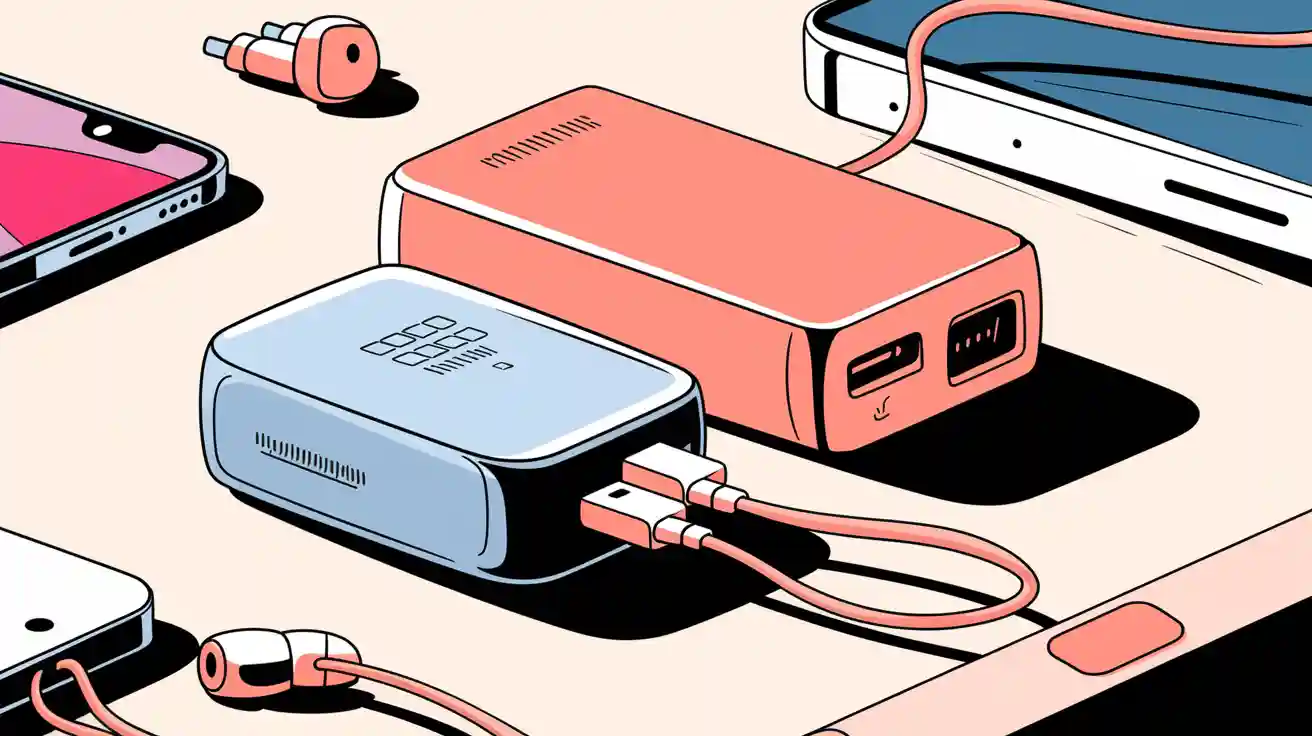
Are portable battery chargers and power banks the same? While the terms “portable battery charger vs power bank” are often used interchangeably, they are not exactly identical. Power banks come with built-in batteries to store energy. On the other hand, portable battery chargers typically depend on external power sources. Both are driven by lithium battery packs, which are fueling a market expected to grow from $6.8 billion in 2021 to $17.3 billion by 2031, with a 9.8% CAGR. This growth highlights the increasing demand for compact, rechargeable solutions, particularly for mobile devices.
Key Takeaways
Power banks hold energy inside. They charge devices anywhere without plugs.
Portable chargers need a plug to work. They are better for home use.
Pick a device based on how much you move and need power.
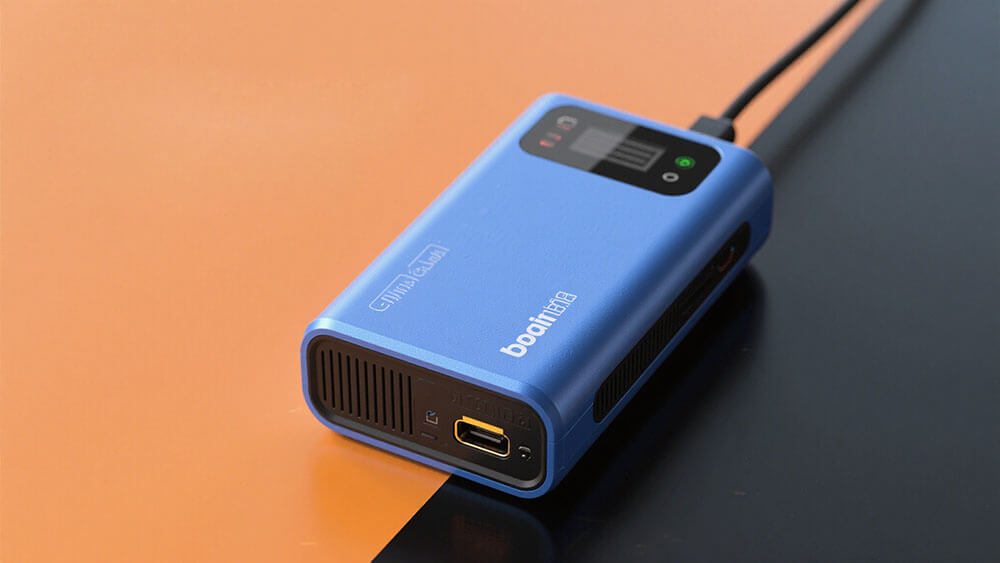
Part 1: What Is a Power Bank?
1.1 Definition and Core Features
A power bank is a portable device designed to store electrical energy and recharge electronic gadgets on the go. It operates using lithium-ion or lithium-polymer batteries, which are known for their high energy density and rechargeability. Unlike other portable chargers, power banks come with built-in batteries, making them self-contained energy sources.
Key features of a power bank include:
Battery Capacity: Measured in milliampere-hours (mAh), it determines how much charge the power bank can store. For instance, the 145W power bank offers 25,000mAh, sufficient for multiple device charges.
Charging Capabilities: Many models support fast charging and can power multiple devices simultaneously.
Port Variety: Power banks often include USB-A, USB-C, and micro-USB ports for compatibility with various devices.
Design: Compact and lightweight designs with LED indicators for battery levels enhance usability.
1.2 How Power Banks Work
Power banks function by storing energy in lithium-ion or lithium-polymer cells. When connected to a power source, they charge these cells using linear circuits. Once charged, the stored energy is regulated and delivered to external devices through USB ports.
The internal engineering of a power bank includes:
Charging the Lithium-Ion Cells: Converts energy from a USB source into stored power.
Battery Protection: Prevents over-voltage, over-current, and under-voltage issues.
Voltage Regulation: Ensures a stable 5V output for device charging.
Boost Converter: Adjusts the battery voltage to meet the requirements of connected devices.
Function | Description |
|---|---|
Charging the Lithium Ion Cells | Handles charging from a USB source, typically using linear circuits for efficiency. |
Battery Protection | Protects against over-voltage, over-current, and under-voltage to prevent hazards. |
Voltage Regulation | Generates 5V output from the 2.7-4.2V of the lithium-ion cell for device charging. |
Device Detection | Detects the presence of a device to be charged and signals its charging capabilities. |
Boost Converter | Converts the battery voltage to the required output voltage for charging external devices. |
1.3 Business Use Cases for Power Banks
Power banks are indispensable for businesses that rely on mobile technology. They ensure uninterrupted operations by providing portable energy solutions. For example:
Consumer Electronics: Retailers and manufacturers use power banks to test devices or provide charging solutions for customers.
Industrial Applications: Field technicians and engineers depend on power banks to keep tools and devices operational in remote locations.
Medical Equipment: Portable medical devices, such as glucose monitors, benefit from reliable power banks to ensure patient care.
Robotics and Security Systems: Power banks support robots and surveillance equipment during power outages or in areas without infrastructure.
For businesses considering buying a power bank, evaluating battery capacity, charging speed, and durability is essential. Custom solutions tailored to specific industries, such as those offered by Large Power, can further enhance operational efficiency.
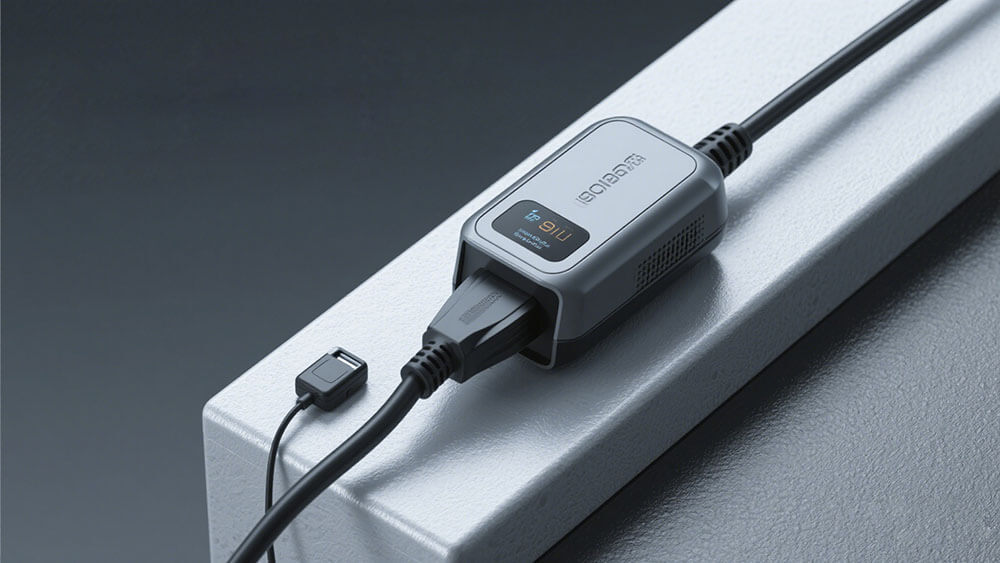
Part 2: What Is a Portable Charger?
2.1 Definition and Core Features
A portable charger is a device designed to recharge electronic gadgets by drawing power from an external source. Unlike power banks, which store energy internally, portable chargers rely on a direct connection to a power outlet or another energy source. These chargers are essential for maintaining device functionality during travel or in areas with limited access to power infrastructure.
Key features of portable chargers include:
Types of Portable Battery Chargers: Linear chargers, which are cost-effective and suitable for low-noise applications, and switching chargers, which are efficient for medium to high currents.
Energy and Power Metrics: Energy is measured in Watt-hours (Wh), while power is measured in Watts (W), indicating the speed of energy consumption.
Connector Options: USB-C connectors, capable of transmitting up to 240 W, enhance compatibility with modern devices.
Battery Life and Lifespan: These metrics determine how long a charger can operate and how many cycles it can endure before replacement.
Feature | Description |
|---|---|
Types of Chargers | Linear chargers for simplicity; switching chargers for efficiency. |
Energy and Power Metrics | Energy in Wh; power in W for consumption speed. |
Connector Options | USB-C supports high power transmission. |
Battery Life and Lifespan | Indicates operational duration and replacement frequency. |
2.2 How Portable Chargers Work
Portable chargers operate by converting electrical energy from an external source into a form usable by electronic devices. The process involves advanced engineering principles:
Electromagnetic Induction: Motion-powered chargers utilize Faraday’s Law to generate electromotive force (EMF) through magnetic flux changes.
Energy Conversion Components: Devices like the op-amp LM324N and Darlington transistor TIP122G play critical roles in converting and regulating energy.
Voltage Regulation: Ensures stable power delivery to connected devices, preventing damage from fluctuations.
These chargers are engineered for efficiency, making them ideal for professionals who require reliable charging solutions during busy schedules.
2.3 Business Use Cases for Portable Chargers
Portable chargers enhance productivity across various industries by ensuring uninterrupted device operation. Businesses benefit from their convenience and adaptability:
Corporate Professionals: Stay connected during meetings and access documents without worrying about battery life.
Event Management: Provide charging solutions during conferences where power outlets are scarce.
Industrial Applications: Field workers use portable chargers to power tools and devices in remote locations.
Wearable Technology: Health-conscious consumers rely on portable chargers to keep fitness trackers and smartwatches operational.
The growing demand for portable chargers reflects the proliferation of smart devices, with over 1.5 billion smartphones sold in 2022. Urbanization and the rise of wearable technology further drive adoption. Businesses seeking the best portable battery charger should consider capacity, charging speed, and compatibility with their devices. For tailored solutions, explore Large Power’s custom battery options.
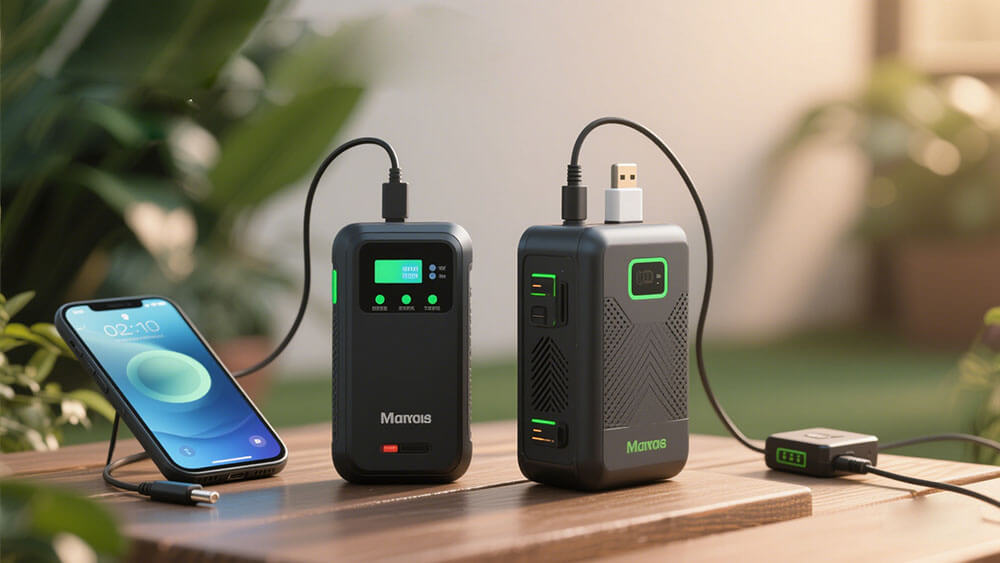
Part 3: Portable Battery Charger vs Power Bank: Key Differences
3.1 Internal Battery vs. External Power Source
The primary distinction between a power bank and a portable battery charger lies in their energy sources. A power bank contains an internal battery, typically a lithium-ion or lithium-polymer battery, which stores energy for later use. This self-contained design allows you to charge devices without needing an immediate connection to an external power source. For example, a power bank with a 10,000mAh battery capacity can recharge a smartphone multiple times, making it ideal for on-the-go use.
In contrast, a portable battery charger relies on an external power source, such as a wall outlet or a car adapter, to function. It does not store energy internally but instead transfers power directly to your device. This makes portable chargers more dependent on infrastructure availability, limiting their utility in remote or off-grid locations.
Feature | Power Bank | Portable Battery Charger |
|---|---|---|
Energy Source | Internal battery (e.g., lithium-ion) | External power source (e.g., wall outlet) |
Portability | Fully portable; works without external power | Requires access to an external power source |
Use Case | Ideal for travel and outdoor activities | Best for stationary or semi-mobile use |
Tip: If your business operates in remote areas or requires uninterrupted power, investing in a high-capacity power bank is a practical choice. For tailored solutions, consider Large Power’s custom battery options.
3.2 Capacity and Charging Efficiency
When comparing the capacity and charging efficiency of these devices, power banks often have the upper hand. Their capacity, measured in milliampere-hours (mAh), determines how much energy they can store. For instance, a power bank with 20,000mAh can charge a standard smartphone approximately five times. Portable battery chargers, on the other hand, do not have a capacity rating since they do not store energy.
Charging efficiency also varies. Power banks equipped with advanced battery technology, such as high-capacity lithium-ion cells, can deliver faster and more consistent charging. Key performance benchmarks include:
Maximum charging speed, measured in kilowatts, which indicates how quickly a device can recharge.
Charging curves, which show how well a power bank sustains its peak charging speed over time.
The integration of high-capacity batteries, which enhances overall charging performance.
Portable chargers, while efficient in transferring power, depend on the quality of the external power source. This dependency can result in inconsistent charging speeds, especially in areas with unstable electricity.
Note: When buying a power bank, prioritize models with high capacity and fast-charging capabilities to ensure optimal performance for your business needs.
3.3 Portability and Design Considerations
Portability and design play crucial roles in determining the practicality of these devices. Power banks are designed to be compact and lightweight, making them easy to carry in a bag or pocket. Many models also feature LED indicators, multiple ports, and durable casings, enhancing their usability and longevity.
Portable chargers, while generally smaller, are less versatile due to their reliance on external power. However, advancements in design have led to the development of more user-friendly and efficient models. For example:
The demand for portable medical devices has driven innovations in lightweight and accessible designs.
Consumer interest in wearable technology has resulted in compact chargers that seamlessly integrate with smartwatches and fitness trackers.
Aspect | Power Bank | Portable Battery Charger |
|---|---|---|
Portability | Highly portable; works anywhere | Limited by the need for external power |
Design Features | LED indicators, multiple ports, durable | Compact but less versatile |
Market Trends | Increasing demand for high-capacity models | Focus on lightweight and efficient designs |
Insight: Businesses in industries like healthcare and consumer electronics can benefit from portable solutions tailored to their specific needs. Explore Large Power’s custom battery solutions for more options.
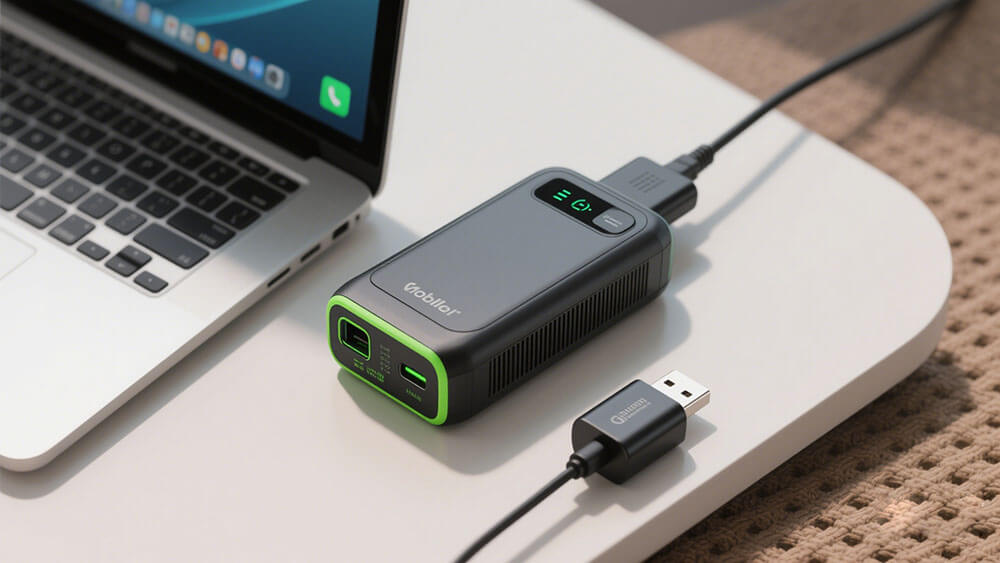
Part 4: Power Bank vs Portable Charger: How to Choose for Your Business
4.1 Assessing Capacity Needs
Understanding your business’s energy requirements is the first step in choosing between a power bank and a portable battery charger. Capacity, measured in milliampere-hours (mAh), determines how much energy a device can store or transfer. For example, a power bank with 20,000mAh can charge a smartphone multiple times, making it ideal for businesses that rely on mobile devices during travel or fieldwork.
To evaluate capacity effectively, consider the following metrics:
Metric | Description |
|---|---|
Round-Trip Efficiency (RTE) | Measures the efficiency of energy storage systems, indicating how much energy is lost during storage. |
Coulomb Efficiency (CE) | Assesses the efficiency of a battery in storing and releasing energy in one cycle. |
Depth of Discharge (DoD) | Indicates the percentage of energy discharged relative to the overall capacity of the storage system. |
State of Health (SOH) | Reflects the overall condition and longevity of the energy storage system. |
Tip: If your business requires uninterrupted power for critical operations, prioritize power banks with high RTE and DoD values. This ensures maximum energy utilization and reliability.
4.2 Evaluating Portability Requirements
Portability plays a crucial role in operational efficiency, especially for businesses that operate in dynamic environments. Power banks are highly portable due to their compact design and internal energy storage. They are perfect for industries like event management or field services, where access to infrastructure is limited.
Portable chargers, while smaller, depend on external power sources. This reliance can limit their utility in remote locations. However, their lightweight design makes them suitable for stationary setups or semi-mobile use cases. Studies show that data portability fosters innovation and operational efficiency by enabling businesses to adapt quickly to changing needs.
Insight: For businesses prioritizing mobility, power banks offer the best solution. Their ability to function independently of external power sources ensures seamless operations in any environment.
4.3 Considering Lithium Battery Pack Specifications
Lithium battery packs are the backbone of both power banks and portable chargers. Their performance directly impacts energy storage, charging speed, and device longevity. Lithium-ion batteries, for instance, offer high energy density and rechargeability, making them a popular choice for power banks.
Key specifications to consider include:
Component | Description |
|---|---|
Continuous Output Power (W) | 240 (2 batteries) |
Battery Bank (Wh) | 920 |
Operating Temp. Range (F) | 50-104° |
Hot Swappability | Yes |
Dimensions & Weight | 17.75″ W x 11.63″ L x 10″ H / 15 lbs. (451 x 295 x 254 mm) / (6.8 kg) |
Note: When evaluating lithium battery packs, consider factors like energy density, operating temperature range, and hot-swappability. These features ensure optimal performance and adaptability to your business needs.
For more insights into lithium-ion technology, explore Large Power’s lithium-ion battery solutions.
4.4 Matching the Device to Your Business Use Case
The final step in your decision-making process involves aligning the device with your specific business requirements. Power banks are ideal for industries like consumer electronics, where uninterrupted power is critical for testing and customer support. Portable chargers, on the other hand, are better suited for corporate professionals who need quick charging solutions during meetings or presentations.
Consider the following factors when matching a device to your use case:
Mobility Needs: If your operations involve frequent travel, a high-capacity power bank is the best choice.
Device Compatibility: Ensure the device supports multiple ports and fast-charging capabilities.
Durability: Opt for models with robust designs to withstand daily wear and tear.
Call to Action: For tailored solutions that meet your business’s unique needs, consult Large Power’s custom battery solutions.
Power banks and portable chargers serve distinct purposes. Power banks store energy for on-the-go use, while portable chargers rely on external power sources. Lithium battery packs ensure efficiency and reliability in both devices. For businesses, power banks are the best choice for mobility, while portable chargers suit stationary needs.
FAQ
1. What is the lifespan of a power bank?
Most power banks last 3-5 years, depending on usage and battery quality. Regular maintenance and avoiding overcharging extend their lifespan.
2. Can portable chargers damage devices?
Portable chargers with poor voltage regulation may harm devices. Choose models with built-in safety features like over-voltage protection to ensure safe charging from Large Power.
3. Are power banks suitable for all devices?
Power banks work with most USB-compatible devices. Check the voltage and capacity requirements of your device before use to avoid compatibility issues.





